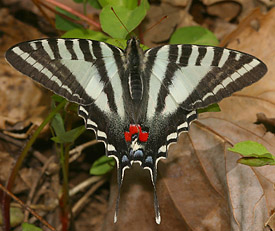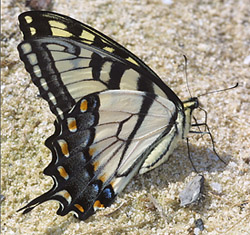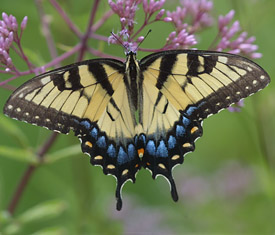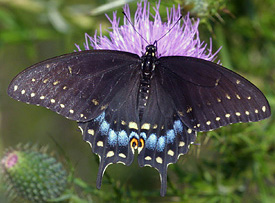A lot of people find learning to identify butterflies difficult. These pages were created to help narrow down your local choices and hopefully give you a sense of what you might see in your area. Once you get to know these butterflies, the whole process of learning to identify them will become easier with every day in the field or your own garden. Remember to check out the size, flight times and range maps to understand what is flying where you are and when.
Below the common species are listed starting with the most common
The most common swallowtail you will find is the yellow Eastern Tiger Swallowtail. The other yellow swallowtails are rare unless it is spring and you're in the Appalachian mountains you might see the Appalachian Tiger Swallowtail. This species is found region-wide throughout most of the season. The Eastern Tiger has a dark form female. Roll over the two images below to see it. The “tiger” striping can be seen from below very easily.
 |
Wingspan: 2 1/2 - 4 1/2 inches. Flight: Mid March until mid October |
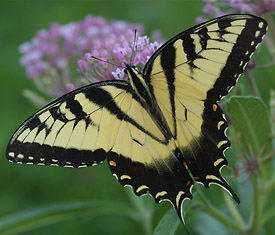
Male, note how black the rear of hindwing is
This is the second most common swallowtail in the region. It is one of five dark swallowtails that we have in the region; these take some effort to tell apart. Spicebush Swallowtails are usually found in much smaller numbers that the other common swallowtails.
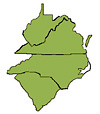 |
Wingspan: 2 1/2 - 4 1/2 inches Flight: Early April until mid September |
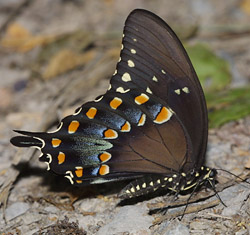
Notice the two rows of orange spots on the hindwing?
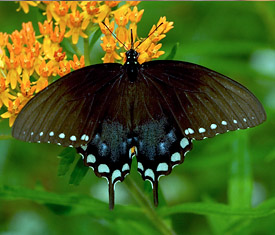
Females have a reduced blue cast to the hindwings. Notice the large blue-green spots on the hindwings.
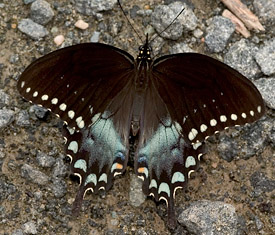
Males have a bold blue cast to the hindwings. Notice the blue-green spots on the hindwing they seem to flow right into the blue-green forewing spots.
This species is somewhat common in the mountains yet found in small numbers anywhere else in the region. They tend to fly in from the woods and make quick visits to the garden and disappear back into the woods.
 |
Wingspan: 2 1/2 - 4 1/4 inches Flight: Early April until mid September |
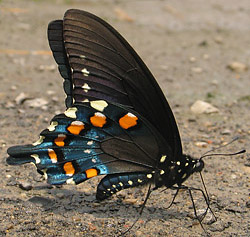
Notice the orange spots in a "C" pattern.
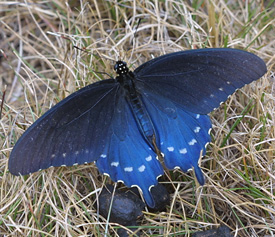
Nearly all black above with a bluish-green cast to the forewing.
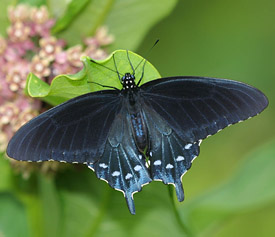
Males usually have reduced pale spots and sometimes no spots.
This species is common yet not very abundant in the region. Just north of the region the Black Swallowtail is much more common. Black Swallowtails are easy to raise in your garden-just plant dill, fennel or parsley and they will find it.
 |
Wingspan: 2 3/8 - 3 3/4 inches Flight: Late March until mid October |
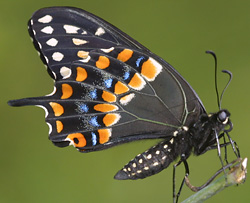
Notice the hindwing has a nearly straight doubled band of orange spots.
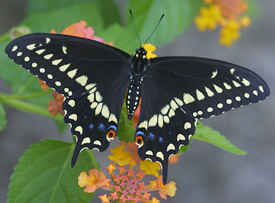
Males have a yellow band across both the hindwing and forewing and a little blue on the hindwing.
This species is very common and abundant in the coastal plain typically east of I-95. Not found in the mountains and rarely found in the piedmont. Palamedes Swallowtail can be found by the hundreds!
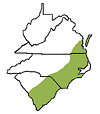 |
Wingspan: 3 1/2 - 4 1/2 inches Flight: Late March until mid October |
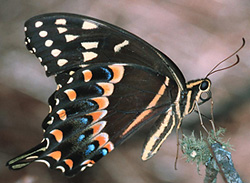
Note the yellow stripe at the base of the hindwing, the is a very easy clue.

Lighter brown with a yellow band above in a Vee pattern.
This species is uncommon at best in most of the region yet it can be found about anywhere in the region. Usually it is found along moist forests, swamps and along waterways. This species is likely the easiest swallowtail to identify, even from a distance the newspaper coloring is seen easily.
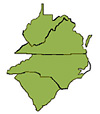 |
Wingspan: 2 1/2 - 4 inches Flight: Early April until early October |
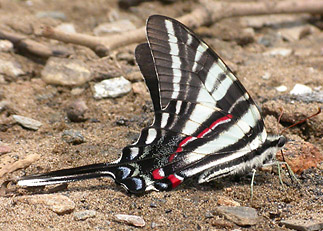 |
Spring is the best time to find it as it can be harder to find during summer. Also note how much longer the tails are than those of the other swallowtails. |
